
* From the 1990s, Dassault developed a next-generation series of executive jets, starting with the "Falcon 2000" -- a follow-on to the Falcon 20. The company also developed the "Falcon 7X" and "Falcon 8X" tri-jets, and is introducing the "Falcon 6X" and "Falcon 10X" twinjets. Again, for the most part, sales were for civil operations, but some military / special operations machines were also sold.
* By eliminating an engine and cutting down the length of the Falcon 900, Dassault came up with a next-generation Falcon twinjet, the "Falcon 2000", with 8 to 10 passenger seats. It was announced in 1990; initial flight was on 4 March 1993, with certification late in the next year, and initial customer deliveries in early 1995.
The Falcon 2000 was similar in configuration to the Falcon 20/200. It was a low-wing aircraft with all-swept flight surfaces, the tailplane being mid-mounted on the tailfin, with a turbofan on each side of the rear fuselage. It had the same tricycle landing gear arrangement, all assemblies with twin wheels, the steerable nose gear retracting forward, the main gear tucking in from the wings into the fuselage.
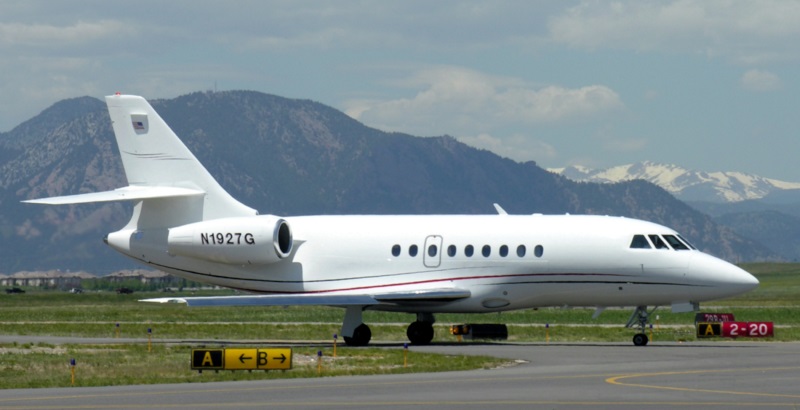
The Falcon 2000, however, was a new design. While it was primarily made of aluminum alloy, it also had some composite assemblies. It was powered by twin CFE738-1-1B turbofans with 26.7 kN (2,720 kgp / 6,000 lbf) thrust each and clamshell thrust reversers. There was an integral fuel tank in each wing, plus a fuel tank under the floor fore and aft -- total fuel capacity being 6,865 liters (1,814 US gallons).
The wing had compound sweep, 24.8 degrees inboard, 29 degrees outboard, at quarter-chord; each wing had double-slotted flaps, a slat on the outboard section, and three spoilers / airbrakes on the top of the wing. The tailplane had noticeable anhedral droop. All flight control surfaces were electrically driven.
___________________________________________________________________
DASSAULT FALCON 2000DX:
___________________________________________________________________
wingspan:
19.33 meters (63 feet 5 inches)
wing area:
49 sq_meters (527 sq_feet)
length:
20.23 meters (66 feet 4 inches)
height:
7.06 meters (23 feet 2 inches)
empty weight:
9,405 kilograms (20,735 pounds)
MTO weight:
16,240 kilograms (35,800 pounds)
cruise speed:
850 KPH (530 MPH / 470 KT)
service ceiling:
14,330 meters (47,000 feet)
range:
5,790 kilometers (3,595 MI / 3,125 NMI)
___________________________________________________________________
The Falcon 2000 was also distinctly bigger than the Falcon 20/200, with the wider fuselage of the Falcon 900. Normal luxury accommodations were eight seats, plus a sofa, with tables and other niceties. High-density configurations of up to 19 seats were also available. There was a toilet in the rear and a galley / wardrobe up front. There was a baggage hold in the rear fuselage, accessible from the cabin, as well as from a door on the lower left rear of the fuselage. There were ten oval windows on each side of the fuselage, providing a recognition feature; a downward-opening airstair door on the forward left fuselage; and an emergency exit over the wing on the right fuselage.
Avionics featured a Collins Pro Line "glass cockpit" with four CRT displays, and color weather radar as standard, with a satcom system optional.
* A refined variant, the "Falcon 2000EX", was introduced in 2003. It featured Pratt & Whitney Canada (PWC) PW308C turbofans with improved fuel efficiency, and range extended from 5,555 kilometers (3,450 MI / 3,000 NMI) to 7,035 kilometers (4,370 MI / 3,800 NMI). A year later, it was replaced in production with the "Falcon 2000EX EASy", which was the Falcon 2000EX with a version of the Honeywell Primus Epic / EASy cockpit -- with 36-centimeter (14-inch) diagonal flat-panel color displays, both pilot and copilot having trackball-like "cursor control devices (CCDs)", allowing each to control their own "primary" display and the two shared central multifunction displays. Keyboards next to the CCDs allowed the pilot or copilot to enter data.
A reduced-range derivative of the Falcon 2000EX EASy, the "Falcon 2000DX", was introduced in 2007; range was cut to 6,015 kilometers (3,735 MI / 3,250 NMI). In 2010, Dassault then introduced the "Falcon 2000LX", which was an extended-range version of the Falcon 2000EX EASy -- featuring winglets designed by Aviation Partners, and a range of 7,400 kilometers (4,595 MI / 4,000 NMI), introduced in 2010. Winglets could be retrofitted to earlier variants.

Two variants were introduced in 2013:
* Over 300 Falcon 2000s have been sold to date. Production is now slowly being transferred to a factory in India.
Along with the militarized Falcon 20s and Falcon 50s, Dassault also developed a militarized version of the Falcon 2000LXS, manifested as the "Maritime Patrol Aircraft (MPA)" and "Multi-Mission Aircraft (MMA)". The Japan Coast Guard (JCG) obtained a variant of the MPA, the "Maritime Surveillance Aircraft (MSA)", with what would end up being a total of five ordered from 2015, initial delivery being in 2019. The Japanese MSAs featured:
Unlike the MPA definition, the Japanese MSAs did not have underwing stores attachments.
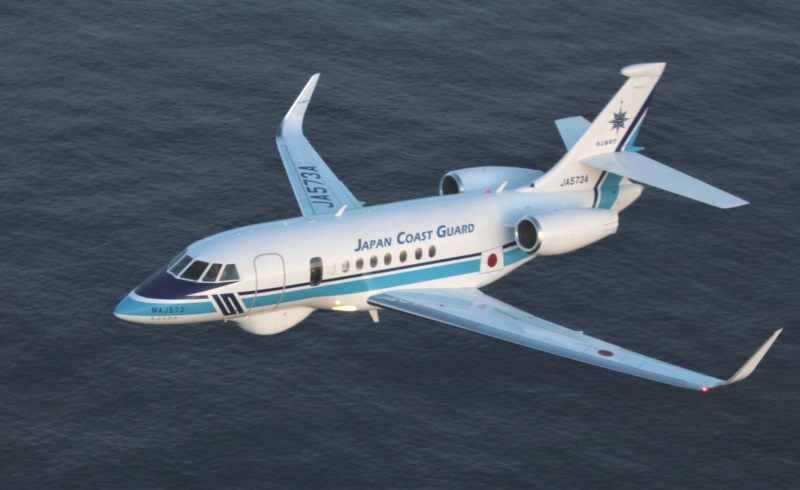
Two Falcon 2000S MMA machines configured for surveillance were delivered to South Korea in 2011. Their exact configuration was not revealed, but they featured a synthetic-aperture radar antenna fairing, an EO-IR turret, and fairings for SIGINT gear. South Korea ordered four more MMA machines in 2021 under the "Baekdu II" program, with little said about their configuration, other than that they will replace elderly "Baekdu I" Hawker 800 bizjets configured for the surveillance role. They will be outfitted with mission gear in South Korea.
The Aeronavale is now obtaining Falcon 2000 MSA machines for the "Avion de Surveillance et d'Intervention Maritime (AVISMAR)" program, these aircraft to be very similar to the Japanese MSA machine, and named "Albatros". It will have a slightly different equipment fit, including:
Seven Albatros machines are to be obtained initially, with five more to be acquired later, and initial deliveries in 2023. They will replace the Falcon 200 Gardians and the Falcon 50Ms currently operated by the Aeronavale. The French government also obtained four Falcon 2000s as VIP transports.
It should be added that the German Aerospace Research & Space Center (DLR in its German acronym), has obtained a Dassault Falcon 2000LX as an "inflight Systems & Technology Airborne Research (iSTAR)" testbed. It will eventually be able to simulate a wide variety of aircraft designs in a flight-test environment.
BACK_TO_TOP* The Falcon tri-jet line remaining popular, in 2001 Dassault launched development of a further refined tri-jet, with the "Falcon 7X" program revealed at the Paris Air Show in 2001. Initial flight of the first of three prototypes was on 5 May 2005, with introduction to service in 2007.
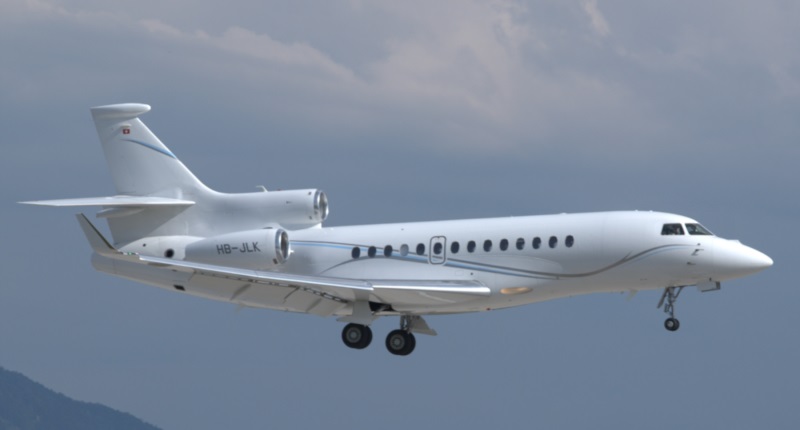
The Falcon 7X was effectively a stretched and redesigned Falcon 900, the two being hard to tell apart -- both featuring a low wing with winglets, all-swept flight surfaces, tri-jet configuration, plus tricycle landing gear with dual wheels on each assembly. Significant differences from the Falcon 900 included:
It was fitted with a version of the Honeywell Primus Epic / EASy glass cockpit. It could be fitted with luxury accommodations for from 8 to 19 passengers, with considerable variation in passenger fit. Over 250 Falcon 7X machines have been delivered to date.
___________________________________________________________________
DASSAULT FALCON 7X:
___________________________________________________________________
wingspan:
26.21 meters (86 feet)
wing area:
70.7 sq_meters (761 sq_feet)
length:
23.19 meters (80 feet 1 inch)
height:
7.83 meters (25 feet 8 inches)
MTO weight:
31,750 kilograms (70,000 pounds)
max speed:
955 KPH (595 MPH / 516 KT)
cruise speed:
850 KPH (530 MPH / 460 KT)
service ceiling:
15,545 meters (51,000 feet)
range:
11,010 kilometers (6,840 MI / 5,950 NMI)
___________________________________________________________________
* The extended-range "Falcon 8X" was announced in 2014. It featured a further stretched fuselage, extended from 23.19 meters (76 feet 1 inch) to 24.46 meters (80 feet 2 inches); a refined wing, plus an updated digital flight control system; and PWC PW307D turbofans, with 29,9 kN (3,050 kgp / 6,720 lbf) thrust each. Range was extended by 8%, thanks to improved aerodynamics and the new engines. It had an updated EASy cockpit, featuring the "FalconEye" enhanced vision system -- based on a head-up display that integrated terrain database data with day-night camera imagery.
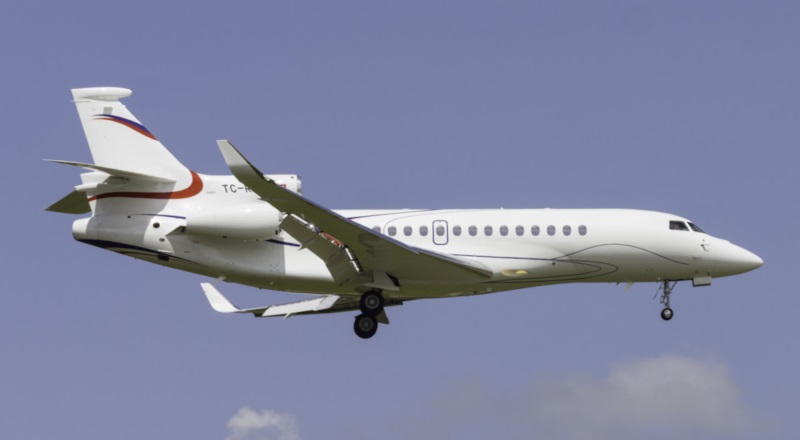
Dassault advertised the Falcon 8X as able to connect non-stop Hong Kong to Paris, or Los Angeles and Beijing. Initial flight of a prototype was on 6 February 2015, with first customer deliveries in the fall of 2016. As of 2021, the Dassault Falcon 900 / 7X / 8X are the only tri-jets still in production, anywhere in the world.
The Armee de l'Air de l'Espace (AAE), the French aerospace force, plans to obtain three Falcon 8X machines with a SIGINT payload, under the "Avions de Renseignement a Charge Utile de Nouvelle Generation (ARCHANGE / Intelligence Aircraft With Next-Generation Payload)". The ARCHANGE Falcon 8X machines will carry the "Capacite Universelle de Guerre Electronique (CUGE / Universal Electronic Warfare Capability)" payload -- derived from the electronic warfare suite developed for the Dassault Rafale fighter and which will feature, among other things, artificial intelligence technology. The three aircraft will replace two existing Transall C-160 Gabriel SIGINT machines. Initial delivery will be in 2025.
BACK_TO_TOP* In 2006, Dassault began development of a new executive twinjet, the "Falcon 5X". The configuration was projected to be along the lines of the Falcon 2000, though with winglets by default and larger, with a normal capacity of 16 passenger seats. It was to have a long range of 9,630 kilometers (5,735 MI / 5,200 NMI), a relatively wide fuselage diameter of 2.7 meters (8.86 ft), and be powered by twin SNECMA (now Safran) Silvercrest turbofans.
Problems with Silvercrest development delayed the first flight of the prototype to 5 July 2017. However, Silvercrest problems continued; Dassault management, concluding that there was no way to introduce the Falcon 5X to service by 2020, killed the program. The program was quickly rethought as the "Falcon 6X", with the Pratt & Whitney PurePower PW812D geared turbofan selected as the powerplant. Initial flight of the first prototype was on 10 March 2021, with introduction to service in 2023.
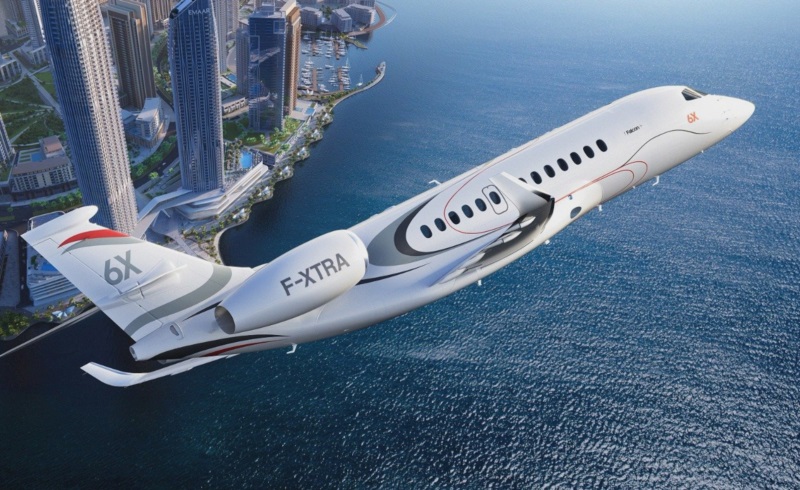
As introduced, the Falcon 6X had an airframe like that of the dead-end Falcon 5X, but was stretched half a meter (20 inches) -- it appears in part to balance the heavier engines. The cabin had a height of 1.98 meters (78 inches) and width of 2.59 meters (102 inches) -- 13 centimeters (5 inches) wider than previous Falcons, Dassault calling it an "ultra-widebody". It also had more fuel capacity than the 5X, giving it a maximum range of 10,175 kilometers (6,320 miles / 5,500 NMI) -- capable of flying Los Angeles to London, New York to Moscow, or Paris to Beijing. The fuel system introduced nitrogen pressurization to reduce fire hazard.
___________________________________________________________________
DASSAULT FALCON 6X:
___________________________________________________________________
wingspan:
25.94 meters (85 feet 1 inch)
wing area:
70.7 sq_meters (761 sq_feet)
length:
25.68 meters (84 feet 4 inches)
height:
7.47 meters (24 feet 6 inches)
empty weight:
19,170 kilograms (42,270 pounds)
MTO weight:
31,135 kilograms (77,460 pounds)
max speed:
955 KPH (595 MPH / 515 KT)
cruise speed:
850 KPH (530 MPH / 460 KT)
take-off distance:
1,670 meters (5,480 feet)
landing distance:
760 meters (2,490 feet)
service ceiling:
15,545 meters (51,000 feet)
range:
10,200 kilometers (6,325 MI / 5,500 NMI)
___________________________________________________________________
The PW812D engines could deliver 60.1 kN (6,120 kgp / 13,500 lbf) thrust each. The wing featured a curved trailing edge to reduce buffeting, as well as both flaps and "flaperons" (flap / ailerons), under the control of a fly-by-wire (FBW) flight control system. Nosewheel steering was integrated into the FBW system, for safer runway handling in strong crosswinds or on wet runways.
The cockpit was fitted with a version of the Honeywell Primus Epic / EASy avionics suite, including four large displays, Honeywell's IntuVue RDR-4000 radar, and the FalconEye head-up display with combined vision system -- featuring overlaid synthetic vision and enhanced vision system imagery. FalconSphere II electronic flight bags were mounted in the console. The Falcon 6X also introduced a FalconScan onboard integrated maintenance system.
* There was talk of a "Falcon 9X", but Dassault skipped that designation, with the "Falcon 10X" unveiled in 2021. As introduced, it was powered by twin Rolls-Royce Pearl 10X engines with 80.1 kN (8,165 kgp / 18,000 lbf) thrust each, and had a range of 13,900 kilometers (8,630 miles / 7,500 NMI). The cabin cross-section was increased to 2.03 meters (6.6 feet) in height and 2.77 meters (9.1 feet) in width. Cabin pressure at cruise altitude was the equivalent of 900 meters (3,000 feet).

The Falcon 10X had a configuration like that of its predecessors, but it was built out of carbon composite materials. It featured a high aspect-ratio wing with high-lift devices to permit operation from short runways. It distinctly differed from earlier Falcons by having a tee tail.
___________________________________________________________________
DASSAULT FALCON 10X:
___________________________________________________________________
wingspan:
33.6 meters (110 feet)
length:
33.4 meters (110 feet)
height:
8.4 meters (28 feet)
empty weight:
27,805 kilograms (61,300 pounds)
MTO weight:
52,165 kilograms (115,000 pounds)
max cruise speed:
985 KPH (610 MPH / 530 KT)
economical cruise speed:
905 KPH (560 MPH / 485 KT)
take-off distance:
1,830 meters (6,000 feet)
landing distance:
760 meters (2,500 feet)
service ceiling:
15,545 meters (51,000 feet)
range:
13,900 kilometers (8,635 MI / 7,500 NMI)
___________________________________________________________________
The Falcon 10X featured an updated digital flight control system, based on that developed for the Dassault Rafale fighter, with a pushbutton recovery mode. It had a version of the Honeywell Primus Epic / EASy glass cockpit with eight touchscreen displays, the FalconEye head-up synthetic vision system, and a single smart throttle that could adjust to differences between the engines, as well as handle thrust reversers and airbrakes. The crew seats could fold flat, to allow a crew member to rest while on a long-duration flight. Introduction to service is planned for 2025.
BACK_TO_TOP* As a footnote to the Dassault Falcon story, it wasn't the only series of French business jets to be built. In the mid-1960s, the French government issued a request for a trainer-liaison aircraft, to be powered by twin turbofan engines, with Sud and Nord Aviation collaborating on a design. They unveiled a model of their design, then designated the "SN 600 Diplomate", in 1968.
In 1970, Sud and Nord merged to become Aerospatiale. The SN 600 prototype performed its first flight on 16 July of that year, being powered by twin Pratt & Whitney JT15D-1 turbofans, with 9.8 kN (1,000 kgp / 2,200 lbf) thrust each. Unfortunately, the prototype crashed on 23 March 1971, which helped bog down the program. Nonetheless, development continued, with the first of two "SN 601 Corvette" prototypes performing its initial flight on 20 December 1972. Work was slow, however, with production machines not being delivered until 1974.
As it emerged, the SN 601 Corvette was an attractive business jet of conventional configuration, with all-swept flight surfaces, a low wing, a tailplane mid-mounted on the tailfin, tricycle landing gear, and a JT15D-4 turbofan on each side of the tail, with 11.1 kN ( kgp / 2,500 lbf) thrust each. There was a short wing fence at mid-span on each wing. It could carry from 6 to 14 passengers; there was a split airstair door on the left forward fuselage, and an emergency escape hatch over the wing on the right. There were five oval windows on each side.
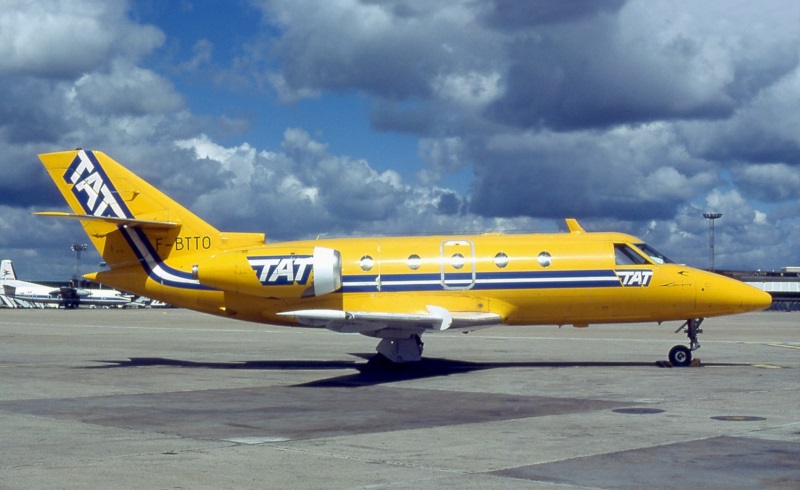
In contrast to the SN 600, the SN 601 had a fuselage stretched by 1.05 meters (3 feet 6 inches) and optional wingtip tanks -- each adding 350 liters (90 US gallons) to the internal fuel capacity of 1,660 liters (440 US gallons). It appears Corvettes were generally sold with the tip tanks.
___________________________________________________________________
AEROSPATIALE SN 601 CORVETTE:
___________________________________________________________________
wingspan:
12.87 meters (42 feet 3 inches)
wing area:
22 sq_meters (236.8 sq_feet)
length:
13.83 meters (45 feet 4 inches)
height:
4.23 meters (13 feet 11 inches)
empty weight:
3,510 kilograms (7,740 pounds)
MTO weight:
6,600 kilograms (14,550 pounds)
max cruise speed:
760 KPH (470 MPH / 410 KT)
normal cruise speed:
565 KPH (350 MPH / 305 KT)
service ceiling:
12,500 meters (41,000 feet)
range, tip tanks:
2,555 kilometers (1,590 MI / 1,380 NMI)
___________________________________________________________________
The SN 601 was a failure, with only 37 production machines sold to end of production in 1976. Development had been muddled and taken too long; it was well more expensive than the competition, such as the Cessna Citation and the Falcon 20.
* This document was originally released in early 2018, and only covered the Falcon twinjets. A follow-on document on the tri-jets was released in mid-2018, with the two documents merged, as planned, in late 2019.
Sources mostly included various editions of JANE'S ALL THE WORLD'S AIRCRAFT, plus Dassault press releases and reviews in flight magazines. Incidentally, I was flattered when I read a news release in THEDIPLOMAT.com on the Japanese Falcon 2000 MSA -- and found the article was using the photo of a Dassault 2000 that I took some years ago at the Rocky Mountain municipal airport in Denver. The photo was public domain, so they were perfectly free to use it.
* Illustrations details:
* Revision history:
v1.0.0 / 01 jun 18 / 1st document, on Falcon twinjets. v1.0.0 / 01 jun 18 / 2nd document, on Falcon tri-jets. v2.0.0 / 01 dec 19 / Merged document. v3.0.0 / 01 aug 21 / Went to 2 chapters, added Falcon 10X & SN 601. v3.1.0 / 01 aug 23 / Review, update, & polish. (*)BACK_TO_TOP
